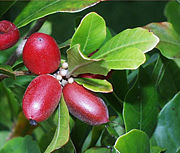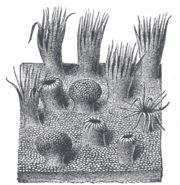Sweetness

Sweet is one of the five basic tastes and is almost universally regarded as a pleasurable experience. Foods rich in simple carbohydrates such as sugar are those most commonly associated with sweetness, although there are other natural and artificial compounds that are much sweeter, some of which have been used as sugar substitutes for those with a sweet tooth. Other compounds may alter perception of sweetness itself.
The chemosensory basis for detecting sweetness, which varies among both individuals and species, has only been teased apart in recent years. The current theoretical model is the multipoint attachment theory, which involves multiple binding sites between sweetness receptor and the sweet substance itself.
Contents |
Examples of sweet substances
- Further information: Sugar substitute
A great diversity of chemical compounds, such as aldehydes and ketones are sweet. Among common biological substances, all of the simple carbohydrates are sweet to at least some degree. Sucrose (table sugar) is the prototypical example of a sweet substance, although another sugar, fructose, is somewhat sweeter. Some of the amino acids are mildly sweet: alanine, glycine, and serine are the sweetest. Some other amino acids are perceived as both sweet and bitter.
A number of plant species produce glycosides that are many times sweeter than sugar. The most well-known example is glycyrrhizin, the sweet component of licorice root, which is about 30 times sweeter than sucrose. Another commercially important example is stevioside, from the South American shrub Stevia rebaudiana. It is roughly 250 times sweeter than sucrose. Another class of potent natural sweeteners are the sweet proteins such as thaumatin, found in the West African katemfe fruit. Hen egg lysozyme, an antibiotic protein found in chicken eggs, is also sweet.
Sweetness of various compounds[1][2]
Even some inorganic compounds are sweet, including beryllium chloride and lead acetate. The latter may have contributed to lead poisoning among the ancient Roman aristocracy: the Roman delicacy sapa was prepared by boiling soured wine (containing acetic acid) in lead pots.
Hundreds of synthetic organic compounds are known to be sweet. The number of these that are legally permitted as food additives is, however, much smaller. For example, chloroform, nitrobenzene, and Ethylene glycol are sweet, but also toxic. As of 2005[update], seven artificial sweeteners are in widespread use: saccharin, cyclamate, aspartame, acesulfame potassium, sucralose, alitame, and neotame. Cyclamate was banned for a short period in the US, and a similar situation occurred in Canada with saccharin.[1]
Sweetness modifiers

A few substances alter the way sweet taste is perceived. One class of these inhibits the perception of sweet tastes, whether from sugars or from highly potent sweeteners. Commercially, the most important of these is lactisole[3], a compound produced by Domino Sugar. It is used in some jellies and other fruit preserves to bring out their fruit flavors by suppressing their otherwise strong sweetness.
Two natural products have been documented to have similar sweetness-inhibiting properties: gymnemic acid, extracted from the leaves of the Indian vine Gymnema sylvestre and ziziphin, from the leaves of the Chinese jujube (Ziziphus jujuba).[4] Gymnemic acid has been widely promoted within herbal medicine as a treatment for sugar cravings and diabetes mellitus.
On the other hand, two plant proteins, miraculin[5] and curculin[6], cause sour foods to taste sweet. Once the tongue has been exposed to either of these proteins, sourness is perceived as sweetness for up to an hour afterwards. While curculin has some innate sweet taste of its own, miraculin is by itself quite tasteless.
The sweetness receptor

Despite the wide variety of chemical substances known to be sweet, and knowledge that the ability to perceive sweet taste must reside in taste buds on the tongue, the biomolecular mechanism of sweet taste was sufficiently elusive that as recently as the 1990s, there was some doubt whether any single "sweetness receptor" actually exists.
The breakthrough for the present understanding of sweetness occurred in 2001, when experiments with laboratory mice showed that mice possessing different versions of the gene T1R3 prefer sweet foods to different extents. Subsequent research has shown that the T1R3 protein forms a complex with a related protein, called T1R2, to form a G-protein coupled receptor that is the sweetness receptor in mammals.[7]
Sweetness perception may differ between species significantly. For example, even amongst the primates sweetness is quite variable. New World monkeys do not find aspartame sweet, while Old World monkeys, apes and humans all do.[8] Felidae like cats cannot perceive sweetness at all.
Historical theories of sweetness

The development of organic chemistry in the 19th century introduced many new chemical compounds and the means to determine their molecular structures. Early organic chemists tasted many of their products, either intentionally (as a means of characterization) or accidentally (due to poor laboratory hygiene). One of the first attempts to draw systematic correlations between molecules' structures and their tastes was made by a German chemist, Georg Cohn, in 1914. He advanced the hypothesis that in order to evoke a certain taste, a molecule must contain some structural motif (called a sapophore) that produced that taste. With regard to sweetness, he noted that molecules containing multiple hydroxyl groups and those containing chlorine atoms are often sweet, and that among a series of structurally similar compounds, those with smaller molecular weights were often sweeter than the larger compounds.
In 1919, Oertly and Myers proposed a more elaborate theory based on a then-current theory of color in synthetic dyes. They hypothesized that in order to be sweet, a compound must contain one each of two classes of structural motif, a glucophore and an auxogluc. Based on those compounds known to be sweet at the time, they proposed a list of six candidate glucophores and nine auxoglucs.
From these beginnings in the early 20th century, the theory of sweetness enjoyed little further academic attention until 1963, when Robert Shallenberger and Terry Acree proposed the AH-B theory of sweetness. Simply put, they proposed that in order to be sweet, a compound must contain a hydrogen bond donor (AH) and a Lewis base (B) separated by about 0.3 nanometres. According to this theory, the AH-B unit of a sweetener binds with a corresponding AH-B unit on the biological sweetness receptor to produce the sensation of sweetness.
B-X theory proposed by Lemont Kier in 1972. While previous researchers had noted that among some groups of compounds, there seemed to be a correlation between hydrophobicity and sweetness, this theory formalized these observations by proposing that in order to be sweet, a compound must have a third binding site (labeled X) that could interact with a hydrophobic site on the sweetness receptor via London dispersion forces. Later researchers have statistically analyzed the distances between the presumed AH, B, and X sites in several families of sweet substances to estimate the distances between these interaction sites on the sweetness receptor.
The most elaborate theory of sweetness to date is the multipoint attachment theory (MPA) proposed by Jean-Marie Tinti and Claude Nofre in 1991. This theory involves a total of eight interaction sites between a sweetener and the sweetness receptor, although not all sweeteners interact with all eight sites. This model has successfully directed efforts aimed at finding highly potent sweeteners, including the most potent family of sweeteners known to date, the guanidine sweeteners. The most potent of these, lugduname, is about 225,000 times sweeter than sucrose.
References
Cited
- ↑ 1.0 1.1 John McMurry (1998). Organic Chemistry (4th edition ed.). Brooks/Cole. pp. 468.
- ↑ Susan S. Schiffman (2000) "Synergism among Ternary Mixtures of Fourteen Sweeteners" in Chemical Senses Volume 25 (2), pages 131-140. Entrez PubMed ISSN [http://www.worldcat.org/issn/1464-3553 1464-3553 ISSN 1464-3553]. Retrieved on 2007-09-02
- ↑ Kinghorn, A.D. and Compadre, C.M. Alernative Sweeteners: Third Edition, Revised and Expanded, Marcel Dekker ed., New York, 2001. ISBN 0-8247-0437-1
- ↑ Kurihara, Y. 1992. Characteristics of antisweet substances, sweet proteins, and sweetness-inducing proteins. Crit. Rev. Food Sci. Nutr. 32:231-252.
- ↑ K Kurihara and LM Beidler. Taste-Modifying Protein from Miracle Fruit. Sience 1968, Vol. 161. no. 3847, pp. 1241-1243.
- ↑ Yamashita, H., T. Akabane, and Y. Kurihara. 1995. Activity and stability of a new sweet protein with taste-modifying action, curculin. Chem. Senses 20:239-243.
- ↑ Li X, Staszewski L, Xu H, Durick K, Zoller M et al. (2002) Human receptors for sweet and umami taste. Proc Natl Acad Sci USA 99, 4692–4696 http://www.pnas.org/cgi/content/abstract/99/7/4692
- ↑ Nofre, C., J. M. Tinti and D. Glaser (1995) Evolution of the Sweetness Receptor in Primates. I. Why Does Alitame Taste Sweet in all Prosimians and Simians, and Aspartame only in Old World Simians? Chemical Senses 20: 573-584.
General
- Cohn, Georg (1914). Die Organischen Geschmackstoffe. Berlin: F. Siemenroth.
- Kier L (1972). "A molecular theory of sweet taste". Journal of Pharmaceutical Science 61: 1394. doi:.
- Kitagawa M, Kusakabe Y, Miura H, Ninomiya Y, Hino A (2001). "Molecular genetic identification of a candidate receptor gene for sweet taste". Biochemical and Biophysical Research Communications 283: 236–242. doi:.
- Li XD, Staszewski L, Xu H, Durick K, Zoller M, Adler E (2002). "Human receptors for sweet and umami taste". Proceedings of the National Academy of Sciences of the United States of America 99: 4692–4696. doi:. PMID 11917125.
- Max M, Shanker YG, Huang LQ, Rong M, Liu Z, Campagne F, Weinstein H, Damak S, Margolskee RF (2001). "Tas1r3, encoding a new candidate taste receptor, is allelic to the sweet responsiveness locus Sac". Nature Genetics 28: 58–63. doi:.
- Montmayeur JP, Liberles SD, Matsunami H, Buck LB (2001). "A candidate taste receptor gene near a sweet taste locus". Nature Neuroscience 4: 492–498.
- Nelson G, Hoon MA, Chandrashekar J, Zhang YF, Ryba NJP, Zuker CS (2001). "Mammalian sweet taste receptors". Cell 106: 381–390. doi:.
- Nofre C, Tinti JM (1996). "Sweetness reception in man: the multipoint attachment theory". Food Chemistry 56: 263–274. doi:.
- Sainz E, Korley JN, Battey JF, Sullivan SL (2001). "Identification of a novel member of the T1R family of putative taste receptors". Journal of Neurochemistry 77: 896–903. doi:.
- Shallenberger RS (1963). "Hydrogen bonding and the varying sweetness of the sugars". Journal of Food Science 28: 584–589. doi:.
- Tinti, Jean-Marie & Nofre, Claude (1991). Why does a sweetener taste sweet? A new model. In D.E. Walters, F.T Orthoefer & G.E. DuBois (Eds.), Sweeteners: Discovery, Molecular Design, and Chemoreception, ACS Symposium Series 450, pp. 209–213. Washington, DC: American Chemical Society.
|
|||||||||||||||||
